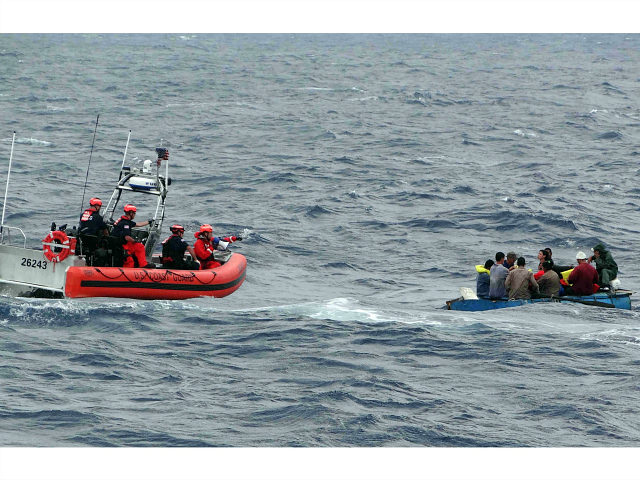With two days left as America’s chief executive, President Barack Obama has approved a series of new agreements with the Cuban Communist Party designed to allow Cuba a greater role in “aeronautical search and rescue” in the Caribbean Sea, where Havana has been targeted and killed Cuban exiles for decades.
The American embassy in Havana, reopened under the Obama administration, announced on Wednesday that the two nations had “bilateral agreement to strengthen cooperation in the field of maritime and aeronautical search and rescue.” The agreement, the embassy claimed, would “enhance effectiveness and efficiency” in cases where individuals were “in distress” in the waters between Cuba and the United States.
Jeffrey DeLaurentis, the embassy’s Charge d’Affairs, said in a statement that the agreement would lead to “improved search and rescue coordination” between the two countries and was merely an expansion of work that had been ongoing “for more than 20 years.”
“I congratulate U.S. and Cuban search and rescue authorities on this historic achievement,” DeLaurentis wrote.
The Cuban government, meanwhile, also approved the measure, which would allow their coast guard a greater range to patrol waters close to the maritime border. “In light of the current increase in air and maritime transport in the region, this agreement gains special importance, and its signing constitutes a positive step in the improvement of relations between the two countries,” Deputy Minister of Transport Marta Oramas Rivero said.
The move follows President Obama’s unilateral decision to revoke the refugee policy known as “wet foot/dry foot,” which allowed American immigration authorities to deem Cubans fleeing to the United States legally present in the country should they touch dry land. The policy was especially important for those fleeing communism in the aftermath of President Obama’s 2014 decision to “normalize” relations with dictator Raúl Castro, which triggered a dramatic increase in the number of political arrests and human rights violations on the island.
The U.S. Coast Guard documented a 117 percent increase in the number of Cuban refugees attempting to reach the United States in rafts and makeshift vessels between December 2013 and December 2014, when President Obama announced the normalization process. The number of Cubans fleeing the island increased 500 percent between 2011 and 2016, with most of the increase following that announcement. An estimated 50,000 Cubans have died trying to reach the United States on these vessels.
The Cuban government has historically been hostile to efforts to rescue Cuban refugees on the high seas, and has repeatedly attacked them, on some occasions killing dozens at a time. The Cuban government has yet to face retribution for two orchestrated killings of civilians during the era of President Bill Clinton in the Caribbean: the mass murder of 41 people, including ten minors, in 1994, and the killing of four Cuban-Americans conducting a rescue operation in 1996.
The latter is often referred to as the “Brothers to the Rescue” incident, after the organization the Cuban government attacked. Four men — Armando Alejandre Jr., Carlos Costa, Mario M. de la Peña and Pablo Morales — flying in U.S. waters were shot down and killed by Cuban military planes while flying a mission searching for Cuban refugees who may have been stranded attempting to reach the United States. While President Clinton “condemn[ed] this action in the strongest possible terms,” the Cuban government
While President Clinton “condemn[ed] this action in the strongest possible terms,” the Cuban government was never sanctioned for the incident, and President Obama took the opportunity of the 20th anniversary of the attack last year to issue an order calling for closer relations with the communist government. The Obama administration called the timing “unintentional” following a public outcry from relatives of those killed.
The Cuban government’s “search and rescue operation” in 1994 is now known as the “March 13 tugboat massacre.” The Cuban government used water cannons to deliberately sink a tugboat full of civilians, including nearly one dozen children, who were attempting to reach the United States. Witnesses say the government appeared to have planned the attack, as government ships were waiting for the tugboat when they left the island.
The youngest victim was a six-month-old infant. The Cuban government published a story in Granma, the government newspaper, dismissing the dead as “antisocials” whom Havana felt it necessary to eliminate.
Cuban dissidents who commemorate the dead are beaten and arrested on an annual basis.
The Cuban government has had decades since these incidents to change, and some have hoped the transfer of power from late dictator Fidel Castro to his younger brother may have triggered some reform. Instead, incidents like this continue. In 2014, for example, the Cuban government sank a vessel attempting to reach the United States despite the presence of an eight-year-old in the vessel.
The U.S. government will now cooperate with Cuban on “search and rescue” efforts, as per the new agreement.

COMMENTS
Please let us know if you're having issues with commenting.